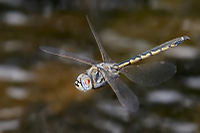
Photo from wikipedia
Flight stabilization in insects is normally achieved through a closed-loop system integrating the internal dynamics and feedback control. Recent studies have reported that flight instability may exist in most flying… Click to show full abstract
Flight stabilization in insects is normally achieved through a closed-loop system integrating the internal dynamics and feedback control. Recent studies have reported that flight instability may exist in most flying insects but how insects achieve the flight stabilization still remains poorly understood. Here we propose a control model specified for bumblebee hovering stabilization by applying a three-axis PD (proportional-derivative)-controller to a free-flying bumblebee computational model with six Degrees of Freedom (DoFs). Morphological and kinematic models of a realistic bumblebee in hovering are built up based on measurements whereas a versatile bio-inspired dynamic flight simulator is employed in simulations. A simplified flight dynamic model is further developed as a fast model for control parameter tuning. Our results demonstrate that the stabilizing control model is capable of achieving the hovering stabilization with small perturbations in terms of 6-DoF, implying that the simplified linear algorithms can still work reasonably for bumblebee hovering. A further sensitivity analysis of the control parameters reveals that yaw control via manipulating pitch angle of the wing is mostly sensitive, implicating that bumblebee may utilize alternative yaw control strategies.
Journal Title: Journal of Bionic Engineering
Year Published: 2018
Link to full text (if available)
Share on Social Media: Sign Up to like & get
recommendations!